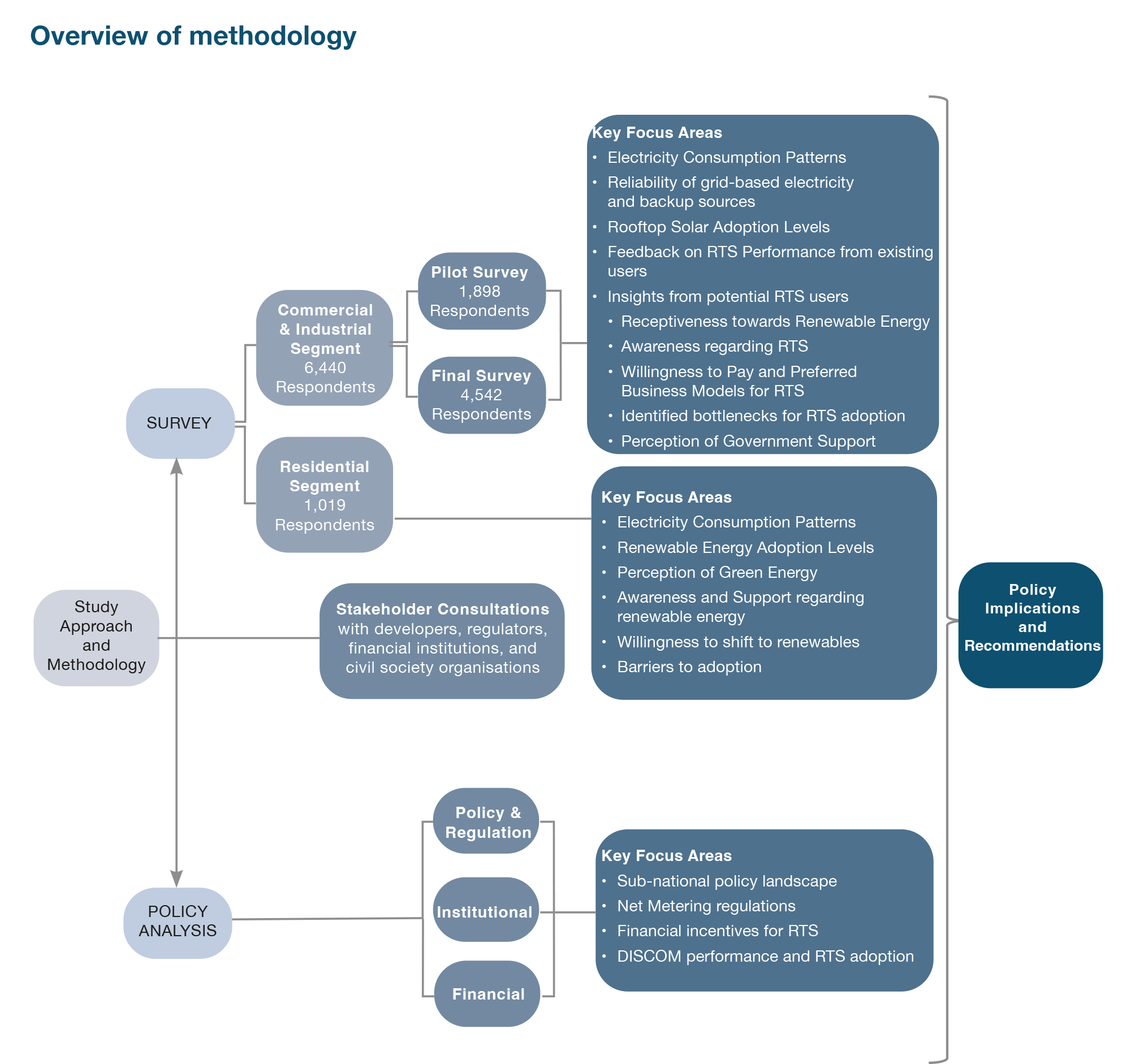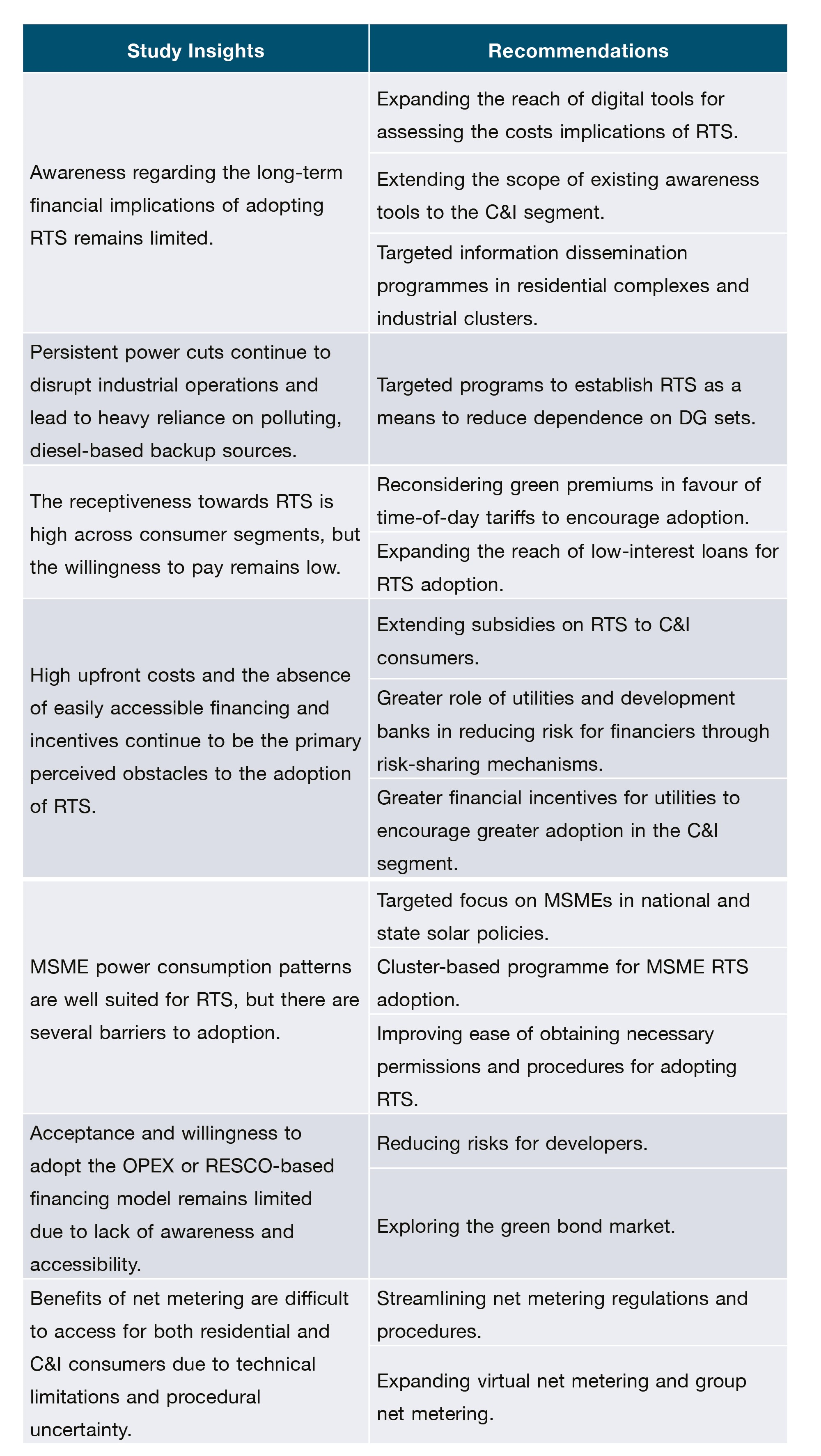Executive Summary
India’s strides in expanding its renewable energy sector have been driven by utility-scale projects. As the nation targets 500 GW of installed renewable capacity by 2030, the role of decentralised solutions such as rooftop solar (RTS) will have to be increasingly prioritised. Power consumers in the residential, commercial, and industrial sectors will also need to play a greater role through active adoption of renewable energy. However, consumers continue to face challenges in transitioning from being passive grid consumers to becoming active adopters of renewables. The slow growth of RTS (only 12 GW of the 40 GW target has been met so far) highlights the significant existing barriers, which current policies and incentives have been unable to adequately address. While several studies have highlighted the techno-economic benefits of decentralised renewable energy solutions, this study aimed to understand consumer perceptions through an extensive on-site survey. The main goal is to understand how different groups of electricity consumers perceive the key technical, informational, policy, and regulatory obstacles that hinder the adoption of renewable energy sources. By bridging the gap between the on-ground realities and the prevailing narratives emerging from top-down assessments, this study has identified the key interventions required to improve consumer acceptance of renewable energy and spur greater adoption of the energy source.
Study Objectives and Research Questions
- To understand the key technical, informational, policy, and regulatory bottlenecks for adopting renewable energy, as perceived by different electricity consumer groups.
- To identify areas of intervention that can resolve the real challenges being faced by consumers.
The study seeks to answer the following questions:
- What is the extent of rooftop solar adoption in different consumer segments, and what are the characteristics of existing users?
- What is the perception and willingness to pay for rooftop solar among power consumers who are yet to switch to renewable energy technologies?
- What are the major perceived barriers to rooftop solar adoption, and how effectively do existing policies address these barriers?
- What are the present electricity consumption patterns for different power consumers, and what do they imply for renewable energy adoption?
Study Approach and Methodology
This study implemented a systematic survey of approximately 7,500 respondents across both the residential and industrial power consumers in six states in India—Uttar Pradesh, Maharashtra, Gujarat, Tamil Nadu, Karnataka, and Andhra Pradesh. To contextualise the survey findings and address policy challenges, the study also analysed national- and state-level regulations concerning renewable energy adoption, with an emphasis on RTS.

Key Survey Findings: Commercial and Industrial Segment
Since previous studies have focused largely on the residential segment, this study prioritised commercial and industrial (C&I) power consumers. A sample of 6,524 C&I consumers were surveyed. The sample was stratified based on the National Industrial Classification (NIC) codes, and the distribution was taken based on the Annual Survey of Industries (ASI) 2018. The final sample included MSMEs as well as larger industries. Electricity consumption patterns
- Significant differences in electricity expenditure were observed between industries. Large industries spent around INR 84 lakh per month on average, while the smallest enterprises spent INR 0.84 lakh. Electricity costs constituted 3 percent of total operational costs on average, with smaller industries spending a higher proportion to electricity expenses.
- The average daily electricity requirement across the sample of industrial units was 11 hours, with larger industries needing up to 17 hours.
- On average, 75 percent of electricity consumption occurred between 9 am and 4 pm for MSMEs, indicating substantial potential for renewable energy adoption even without requiring expensive battery storage solutions.
Reliability of grid-based electricity and backup sources
- Prevalence of power cuts: The majority of the sample faced frequent power cuts that affected business operations, with only about 20 percent reporting no power cuts. Uttar Pradesh had the highest incidence, with 76 percent experiencing daily power cuts, followed by Andhra Pradesh and Gujarat, which had less frequent yet significant interruptions.
- Usage of DG sets: Approximately 47 percent of the sample used DG sets for backup power, with significant variations across states. Tamil Nadu, Karnataka, and Uttar Pradesh had over 90 percent DG-set usage, while Gujarat and Maharashtra had less than 25 percent. The majority (83 percent) of DG-set users relied on large sets above 100 KVA, indicating the crucial role of DG sets in business operations during power outages.
RTS adoption levels
- In the overall sample, 3 percent of respondents utilised RTS, with the highest prevalence in Gujarat (9 percent), followed by Uttar Pradesh (3 percent), Maharashtra (2 percent), and Andhra Pradesh (1 percent). Tamil Nadu and Karnataka had no reported RTS usage.
- Medium-sized enterprises with annual revenues between INR 50 crore and INR 250 crore showed the highest adoption rate (7 percent), while the lowest adoption was in the revenue segment below INR 5 crore. Only 3 percent of respondents in larger industries, with an annual turnover above INR 250 crore, reported using RTS.
- Industries with high RTS prevalence included machinery and equipment manufacturing, pharmaceuticals, basic metals, chemicals, and fabricated metal products.
Insights from existing RTS users
- A majority of the RTS users were found to be medium- to long-term users of solar, with the average age of the RTS system ranging from 4.38 years in Uttar Pradesh to 6.5 years in Andhra Pradesh.
- Around 88 percent of the RTS users had systems connected to the grid. Only 30 percent of the users had some form of battery storage, with these users being concentrated in the larger industries.
- Feedback on RTS performance from existing users:
- Cost savings: Across the sample, respondents rated their electricity cost savings from RTS with an average score of 3.4 out of 5, indicating only moderate satisfaction. Larger industries expressed low satisfaction with RTS cost reductions, challenging the narrative of substantial long-term net cost benefits. Even long-term RTS users did not perceive significant cost savings near the expected cost breakeven point.
- Operation and maintenance (O&M): This remains challenging for adopters, despite major maintenance tasks being handled by developers or O&M companies. Satisfaction with ease of maintenance is generally low, especially for larger industries with higher RTS capacity.
Insights from potential RTS users
- Willingness to shift to renewables: More than 65 percent of the respondents across states and industries expressed a strong willingness to shift to renewable energy. Industries that reported the highest willingness to shift were computer electronic and optical products; furniture; motor vehicles; trailers and semi-trailers; paper products; rubber and plastic products; fabricated metal products; and textiles.
- Preferred mode of adoption: Respondents in most states (five out of six) reported a preference to purchase renewable electricity from the grid, closely followed by setting up an RTS system. Across all industrial segments, respondents were evenly split between those who preferred to purchase renewable electricity from the grid and those who favoured installing RTS systems, with approximately 60 percent of the respondents opting for either choice.
- Willingness to pay: Across all industry segments, more than 60 percent of the respondents were not willing to pay extra for RTS. However, if they are willing, they would prefer making an outright purchase rather than an operational cost-based adoption model, as the respondents considered it to be cheaper in the long run.
- Identified bottlenecks:
- Lack of financing options and the absence of specific subsidies for the C&I segment were identified as the major barriers to the adoption of RTS.
- Most respondents also reported that their main reason for not making the shift to RTS was because they did not perceive any cost savings from its adoption.
- Physical constraints were also identified as a key barrier.
- For MSMEs, the lack of financing options was highlighted as a major barrier to the adoption of RTS. For larger industries, physical constraints also emerged as a major barrier.
- Perceptions regarding government support
- The most preferred interventions to accelerate the adoption of RTS was the subsidisation of purchase cost, closely followed by the provision of low-interest loans.
- There was also a demand for improved net metering regulations from all six states.
Key Survey Findings: Residential Segment
The survey also included a sample of 1,019 residential respondents spread over 40 cities across the six states included in the study. Electricity consumption patterns
- Total electricity consumption correlated positively with average household incomes. The average monthly electricity expenditure across the sample was INR 1,400, with Karnataka (INR 1,829) and Tamil Nadu (INR 1,539) reporting the highest average expenditures.
- The survey revealed significant concerns about the reliability of grid electricity among residential consumers. About 71 percent of respondents experienced power cuts, with respondents in Uttar Pradesh and Maharashtra facing frequent daily power cuts. Gujarat had the lowest power-cut issues, while Andhra Pradesh reported the longest average duration, with 11 hours of power cuts per month.
- Residential consumers had lower utilisation of backup power sources like inverters or DG sets despite frequent power cuts. Only seven respondents reported using backups, which were mostly limited to higher-income households, indicating affordability issues for many.
Renewable energy adoption
- Renewable energy usage among residential consumers was even lower for residential consumers, with only five respondents (<1 percent) using RTS and no other solar-based appliances. This highlights the untapped potential of solar in the residential segment and the urgent need to accelerate adoption.
- The CAPEX-based purchase model was the most common among RTS users, with four out of five adopting this model, spending an average of INR 3.5 lakh. This preference for CAPEX was driven by a lack of awareness about OPEX models.
- Limited availability of RTS loans and high-interest rates (above 10 percent) were significant barriers, resulting in higher-income households adopting CAPEX.
Perception of Green Energy
- 64 percent of the respondents consider the transition to renewable energy to be an urgent policy priority, reflecting broad-based support for India’s renewable energy transition.
- 67 percent of respondents stated the need for greater government incentives to promote green energy adoption.
- Solar energy had the highest awareness and support, followed by wind energy, reflecting their pivotal roles in India’s energy transition.
- Surprisingly, natural gas garnered significant support and was viewed as a crucial transitional fuel in India’s clean energy shift.
Willingness to shift to renewables
- Around 60 percent of the respondents expressed an interest in adopting renewable energy, with 25 percent showing a strong desire. However, Karnataka and Tamil Nadu displayed the lowest willingness to adopt renewables, despite their leadership in utility-scale renewable installations.
- Overall, respondents were evenly split between preferring to install RTS systems and purchasing renewable electricity from the grid. In Maharashtra and Gujarat, most respondents favoured setting up their own RTS systems, indicating the impact of existing adoption rates and proactive state policies in promoting renewable energy uptake.
- Only 24 percent of respondents were willing to pay a higher tariff for renewable electricity from the grid. In Maharashtra, support for the state’s green premium policy was low, with only 16 percent agreeing to pay the premium.
Barriers to adoption
- Financial barriers, such as the high upfront costs and perceived low return on investment, hinder RTS adoption in this segment. Lack of access to OPEX financing models underscores the need for broader implementation to support residential consumers.
- Lack of awareness about evolving renewable technologies and available options poses a significant barrier to adoption. Many respondents expressed difficulties in identifying the most suitable technology, which remains a major barrier to adoption.

Policy Implications and Recommendations Read the report here.
The views expressed above belong to the author(s). ORF research and analyses now available on Telegram! Click here to access our curated content — blogs, longforms and interviews.
 PDF Download
PDF Download 




